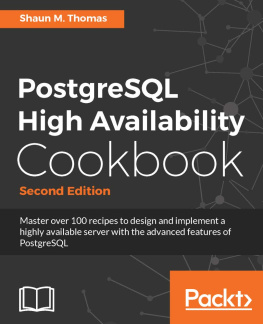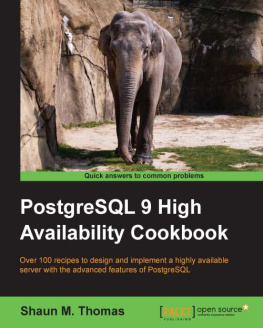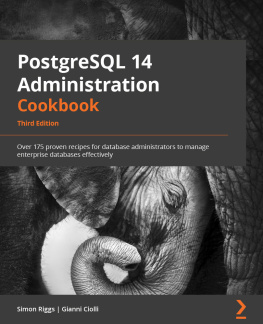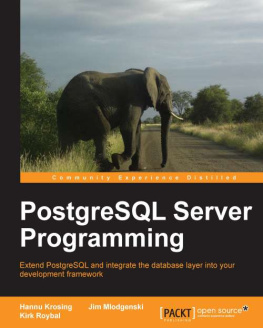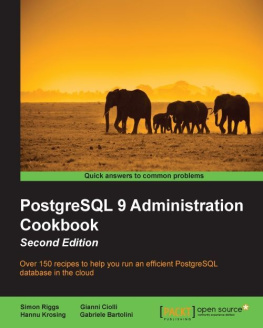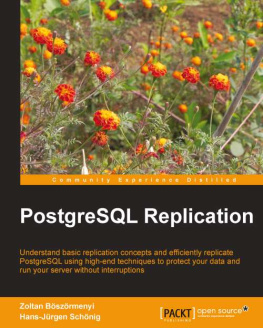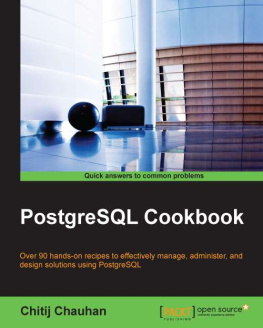
Title Page
PostgreSQL High Availability Cookbook
Second Edition
Master over 100 recipes to design and implement a highly available server with the advanced features of PostgreSQL
Shaun M. Thomas

BIRMINGHAM - MUMBAI
Copyright
PostgreSQL High Availability Cookbook
Second Edition
Copyright 2017 Packt Publishing
All rights reserved. No part of this book may be reproduced, stored in a retrieval system, or transmitted in any form or by any means, without the prior written permission of the publisher, except in the case of brief quotations embedded in critical articles or reviews.
Every effort has been made in the preparation of this book to ensure the accuracy of the information presented. However, the information contained in this book is sold without warranty, either express or implied. Neither the author, nor Packt Publishing, and its dealers and distributors will be held liable for any damages caused or alleged to be caused directly or indirectly by this book.
Packt Publishing has endeavored to provide trademark information about all of the companies and products mentioned in this book by the appropriate use of capitals. However, Packt Publishing cannot guarantee the accuracy of this information.
First published: February 2017
Production reference: 1010217
Published by Packt Publishing Ltd.
Livery Place
35 Livery Street
Birmingham
B3 2PB, UK.
ISBN 978-1-78712-553-7
www.packtpub.com
Credits
Author Shaun M. Thomas | Copy Editor Safis Editing |
Reviewer Sheldon E. Strauch | Project Coordinator Shweta H Birwatkar |
Commissioning Editor Amey Varangaonkar | Proofreader Safis Editing |
Acquisition Editor Ajith Menon | Indexer Rekha Nair |
ContentDevelopmentEditor Sumeet Sawant | Graphics Disha Haria |
Technical Editors Akash Patel | Production Coordinator Melwyn Dsa |
About the Author
Shaun M. Thomas has been working with PostgreSQL since late 2000. He is a frequent contributor to the PostgreSQL Performance and General mailing lists, assisting other DBAs with the knowledge he's gained over the years. In 2011 and 2012, he gave presentations at the Postgres Open conference on topics such as handling extreme throughput, high availability, server redundancy, and failover techniques. Most recently, he has contributed the Shard Manager extension and the walctl WAL management suite. Currently, he serves as the database architect at PEAK6 Investments, where he develops standard operating procedure (SOP) guidelines to facilitate reliable server architecture among many other tasks. Many of the techniques used in this book were developed specifically for this extreme environment. He believes that PostgreSQL has a stupendous future ahead, and he can't wait to see the advancements subsequent versions will bring. https://www.linkedin.com/in/bonesmoses
About the Reviewer
Sheldon Strauch is a 22-year veteran of software consulting at companies such as IBM, Sears, Ernst & Young, and Kraft Foods. He has a Bachelor's degree in Business Administration and leverages his technical skills to improve the business' self-awareness. His interests include data gathering, management, and mining; maps and mapping; business intelligence; and application of data analysis for continuous improvement. He is currently focused on development of end-to-end data management and mining at Enova International, a financial services company located in Chicago. In his spare time, he enjoys the performing arts, particularly music, and traveling with his wife, Marilyn.
www.Packtpub.com
For support files and downloads related to your book, please visit www.PacktPub.com.
Did you know that Packt offers eBook versions of every book published, with PDF and ePub files available? You can upgrade to the eBook version at www.PacktPub.com and as a print book customer, you are entitled to a discount on the eBook copy. Get in touch with us at service@packtpub.com for more details.
At www.PacktPub.com , you can also read a collection of free technical articles, sign up for a range of free newsletters and receive exclusive discounts and offers on Packt books and eBooks.

https://www.packtpub.com/mapt
Get the most in-demand software skills with Mapt. Mapt gives you full access to all Packt books and video courses, as well as industry-leading tools to help you plan your personal development and advance your career.
Why subscribe?
- Fully searchable across every book published by Packt
- Copy and paste, print, and bookmark content
- On demand and accessible via a web browser
Customer Feedback
Thank you for purchasing this Packt book. We take our commitment to improving our content and products to meet your needs seriously - that's why your feedback is so valuable. Whatever your feelings about your purchase, please consider leaving a review on this book's Amazon page. Not only will this help us, more importantly it will also help others in the community to make an informed decision about the resources that they invest in to learn.
You can also review for us on a regular basis by joining our reviewers' club. If you're interested in joining, or would like to learn more about the benefits we offer, please contact us: customerreviews@packtpub.com.
Preface
Welcome to the PostgreSQL 9 High Availability Cookbook! As a database engine, PostgreSQL is settling into its place as a reliable bastion of high-transaction rates and very large data installations. DB-Engines recently listed PostgreSQL as the third most popular database software in the world! With such notoriety comes increasing demand for PostgreSQL to act as a critical piece of infrastructure. System outages in these environments can be spectacularly costly and require a higher caliber of management and tooling.
It is the job of a DBA to ensure that the database is always available for application demands and client needs. Yet this is extremely difficult to accomplish without the necessary skills and experience with common operating-system and PostgreSQL tools. Installing, configuring, and optimizing a PostgreSQL cluster is but a tiny fraction of the process. We also need to know how to find and recognize problems, manage a swarm of logical and physical replicas, and scale to increasing demands, all while preventing or mitigating system outages.
This book is something the author wishes existed 10 years ago. Back then, there were no recipes to follow for building a fault-tolerant PostgreSQL cluster; we had to improvise. It is our aim to prevent other DBAs from experiencing the kind of frustration borne of reinventing the wheel. We've done all the hard work, taken notes, outlined everything we've ever learned about keeping PostgreSQL available, and written it all down in here.
Next page
